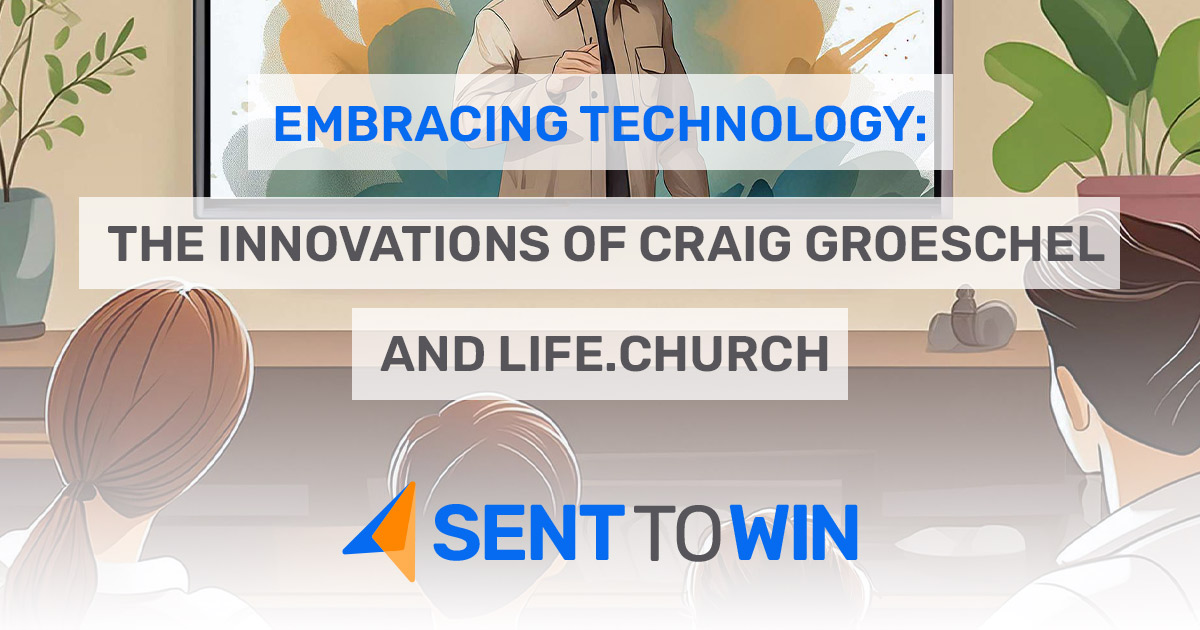Embracing Technology: The Innovations of Craig Groeschel and Life.Church
In today’s newsletter:
- Embracing Technology: The Innovations of Craig Groeschel and Life.Church
- Market Watch, Money in Sports, and Christian Culture Controversies
- Is SEO Going Away? What’s Next for Marketing Products and Services Online?
Some see emerging technology, changing social norms, or cultural shifts as a threat.
Not Craig Groeschel, and the not the megachurch that he founded nearly 30 years ago in a two-car garage in Oklahoma. They have always seen technology and shifting cultural habits as opportunities, to be jumped on as soon as humanly possible.
In other words, they’re something of the ecclesiastical equivalent of “first to market.”
Life.Church (yes, you read that right – Life dot Church) is the largest megachurch in the country, with 44 satellite campuses in 12 states, totaling somewhere around 85,000 in attendance each weekend. How did they grow so large, and in a relatively short span of time?
Mergers, strategic partnerships, and leveraging technology early and often, whenever the opportunity arises.
The Multi-Site Innovation
Life.Church never struggled for attendance. After only 5 years of existence, Life.Church (then called LifeChurch.tv) had already reached a steady weekly attendance of 5,500 between their two locations (having merged with another church early in the year). One Saturday evening, after church, head pastor Craig Groeschel had to run off to the hospital to watch his wife give birth, and so instead of preaching in person Sunday, a recording of his sermon was shown at both campuses.
And a lightbulb went off over Groeschel’s head.
Getting the technology and tactics right took a couple of years, but by 2003, Life.Church was simulcasting their services across four different campuses, so that each congregation was watching the same sermon, at the same time, in different locations.
And a lightbulb went off over a number of other megachurch pastors’ heads.
Today, approximately 91% of churches livestream their worship services, and the “online congregation” is a common topic of discussion in church offices across America.
It is unclear if Life.Church was actually the first church to simulcast across multiple campuses – but if they were not, they were very early in the game, and certainly the most influential.
Groeschel did not want to be limited by geography, the size of a building, or the number of parking spaces. His vision was to be able to send live video feed of his speaking anywhere in the world, and the team at Life.Church made that dream a reality.
Many others followed suit.
The Bible App
In 2006, Life.Church’s Head of Innovation, Bobby Greunewald was standing in line at a Chicago airport, thinking about how the printing press had revolutionized how people interact with the Bible.
Suddenly, he was struck by an idea: What if he could access the Bible more easily using technology?
“I was a below-average Bible reader that had a desire to not be a below-average Bible reader,” Greunewald says of his moment of inspiration. So Greunewald and Life.Church boldly made a website and put the Bible on the internet.
…a decade and a half after the Bible had already been put on the internet.
“It didn’t work,” Groeschel said of their initial foray into digital scripture. He goes on, however, to explain how they pivoted and made an impact. “As a last-ditch effort, we offered a mobile version of the site and engagement took off. Shortly after, we heard Apple would be launching something called ‘apps’… We asked ourselves, ‘What if the Bible could be one of the first apps in the App Store?’”
A 19-year old on Life.Church’s staff (who is unfortunately not named anywhere we can find) created the first Bible app for iPhones, and the Bible App (now called YouVersion) was one of the first 200 applications available to iPhone users. Today, the app has around half a billion downloads, is available in nearly 2,000 languages, and employs a former Facebook executive to fuel growth.
Free Resources Distribution
Life.Church has a far greater reach than its massive 85,000 member congregation, however. According to the church’s reporting, thousands of churches model just about everything they do off of Life.Church’s instructions and resources.
For instance, back in 2008, Life.Church launched “Church Metrics,” an application that tracks church statistics such as giving, attendance, number of reported salvations, etc. and made it available to churches around the globe. It was widely adopted.
In 2012, over 2,000 churches signed up to use the curriculum, sermons, and administrative/business tools that Life.Church posted on their Church Online Platform. This was only the first year, in which 900,000 resources were downloaded by over 40,000 church leaders around the world. Life.Church offers a program called “In Step” with their free resources, in which “network churches” play Groeschel’s weekly sermons in simulcast, use Life.Church’s kid’s curriculum, etc., essentially cloning the ministry and teachings for their congregation.
In 2013, Life.Church trained 5,700 churches on how to enter the online church space.
These examples, all from at least a decade ago, represent the beginning of their influence.
It sounds shocking to hear of a multi-site church with 44 locations and 85,000 members. Groeschel has a huge impact each week! But it is truly mind-blowing, when you consider the model that they have exported, the network churches that stream all of Groeschel’s content to their congregations, the conferences and training seminars they run, the data they collect and export, and the vast number of strategic partnerships they maintain.
If you go to an evangelical church in America, more than likely, Life.Church is at least partially responsible for how your congregation learns, worships, and organizes itself.
At the end of the day, first to market and aggressive innovation is a high-risk, high-reward, high-consequences endeavor. As we see the fruit, the effects, the complications, and the influence of Craig Roeschel’s bold embrace of technology and aggressive growth, it is up to us to analyze the results and take what lessons we may.
INDUSTRY INSIGHTS
Market Watch, Money in Sports, and Christian Culture Controversies
Market Watch
The Dow Jones Industrial Average halted its earlier rally, backing off slightly after once again flirting with 40,000. The Nasdaq has remained relatively flat over the past couple of weeks, and the S&P 500 remains well-entrenched above 5,000. BTC continues to rise and fall daily, oscillating between around $62,000 and $73,000, which is nevertheless up over 50% YTD. Oil continues to climb slowly upward, to $84.15 for a West Texas barrel and $87.68 for Brent crude. Consumer confidence scores dipped slightly to 104.7 in March. The 30-year-fixed mortgage rate continues to hover around 7%, slightly higher or lower depending on locality and timing. Jeremy Grantham says, despite fears to the contrary, that the dollar is still king.
Money in Sports
CNBC declares, for good reason, that ESPN’s business model is “eroding.” Cable TV has lost millions of subscribers per year for the last several years, a trend that is expected to continue as technology and consumption habits shift – creating a problem for ESPN, which has built a company off of high-dollar carriage fees. In response, ESPN will launch its own streaming service in 2025, which will include a personalized user experience and integration with ESPN Bet – an online sports gambling book that ESPN has licensed its name and network to. Betting on sports has been widely legalized since a Supreme Court decision in 2018, and now sports betting is available in nearly 40 U.S. States, leading to the rise of wealthy, powerful new bookies such as Draft Kings, a sports gambling platform that earned well over $1 billion in revenue last year. Incidentally, Draft Kings is in a bitter legal battle concerning corporate espionage with sports merchandise company Fanatics – a company with $8 billion in revenue that will soon launch an IPO. One thing is for sure – the way fans watch sports may be changing, but the money is bigger than ever.
Christian Culture Controversies
Christians have been at odds this past week over a few, unrelated events in the popular culture, sparking debate and conversation as to the best way to express our faith in the public square. First, political commentator Candace Owens parted ways with conservative outlet The Daily Wire amid accusations of antisemitism. She has made the words “Christ is King” her catchphrase, sometimes attaching the phrase as a clapback in debates with Daily Wire host Ben Shapiro and others, and once her firing became public, the phrase trended heavily on X, often paired with vile, blatantly anti-semitic images and rhetoric. This led to an internal debate among Christians online, over how the phrase was being used, and what it means to proclaim the gospel and what it means to take God’s name in vain. Owens does not deny the specific claims made against her, but she does deny being anti-Semitic. Also last week, former president Donald Trump began selling $60 “God Bless the USA” Bibles that he has officially “endorsed” and has licensed his name, likeness, and image to in exchange for a share of the profits. This has sparked heavy criticism from some segments of the Christian community, as some have accused the former president of commoditizing our faith, while others have praised the move as “refreshing.”
Sunday School
Q. What are the three kinds of salvation identified by protestant theology?
A. Justification (accepting Christ’s covering for your sins), Sanctification (the Holy Spirit’s purifying work in you over time to conform you into His likeness), Glorification (resurrection into eternity with God).

“Back in my day, we didn’t have voice commands and AI search engines… We had to click on things, and type in words, with our hands! It was painful, backbreaking. Millions of people ended up with carpal tunnel. Yes, they were tough times – but we were tougher.”
TIPS & TRICKS
Is SEO Going Away? What’s Next for Marketing Products and Services Online?
For two decades, Google has been far and away the go-to source for finding products, services, and information on the web, largely due to their “traffic directing” that finds relevant links to websites that can help the user. As such, their SEO (short for Search Engine Optimization) guidelines are closely watched by digital marketers, all for the purpose of ranking highly on page 1 when a potential customer types something in the search bar.
But the times, they are a changin’.
Arguably, the first really significant change came in 2000, when Google started selling the top few slots as “paid search results.” This did two things: 1) It made it easier for marketers to get their website to the top of the listings now. 2) It made it so that Page 1 of the search results had 3 fewer slots for organic results.
No big deal. We adapted. But with Google’s imminent inclusion of their AI model “Bard,” the search page is about to change drastically once again.
Changes to the Internet Search Results Page
Google is shifting from a purely link-based result and moving towards a more conversational approach that feels less like “Ask Jeeves” and more like “Chat GPT.” This has a lot of implications for digital marketers, but the first is immediately apparent:
There will now be even less real estate on a search results page for links.
The AI-powered answers that Google is moving towards pull from multiple sources online and present the user with information in an attempt to directly answer their query. This large block of text is prioritized at the top of the results, and does not necessarily drive users to your site the way the old system does.
This means a few things for ecommerce:
1) The Wild West is about to be over.
Web 2.0 was an exciting, freewheeling time where anyone could stake a claim on digital real estate, drive traffic, and rake in the rewards. As Google and other search engines shift away from trying to simply direct traffic and instead co-opt your content for repurposing as direct answers, we are heading into more of a “digital feudalism,” where the only way to gain exposure to your products or services is via searches on Amazon, Groupon, Etsy, etc.
Though Google’s SEO guidelines certainly prioritized certain kinds of content, the tech giant nevertheless used to act as a great equalizer. In the future, that is likely to no longer be the case.
2) AEO (Answer Engine Optimization) may soon overtake SEO (Search Engine Optimization).
For those marketers still vying for a share of the shrinking number of clicks from Google, this means stepping away from content aggregation and repurposing, and towards a more straightforward Q&A content library that is easy for AI to understand and pass on. This may include demonstrating expertise and real user experience with your services, products, or industry, and it may mean that new content stays “green” for less time.
3) There may be a way to thread the needle.
For all of our (justifiable) awe over the technology involved with machine learning applications and predictive text mechanisms (such as Chat GPT), the content that they create is, well, not very good.
It’s great for brainstorming or quickly gathering information, but it tends to spit out bland, generic, vague writing that sounds like an earnest yet deeply ignorant seventh-grader with good grammar. This problem only gets worse as AI-generated content floods the internet, and AI models start learning off of AI-generated content, rather than human-created, original material.
Technology moves fast, and it is possible that we’ll see exponential improvement in the output of this tech in the near future, but for the moment, don’t abandon traditional SEO just yet. Keep writing high-quality, relevant material on a consistent basis, optimizing your site’s performance, and building backlinks to high authority sites. Just be ready to change tactics as Google rolls out its new program in the coming months and years.
Need help navigating SEO or other digital marketing strategies? Fidelitas, the Believer-owned agency that powers this newsletter, is a great place to start.
Quick Hits
- A shocking 95% of Americans report plans to look for a new job in 2024, according to a new survey.
- Amidst an ongoing legal battle, Google is on the hook to delete illegally acquired user data.
- Planet Fitness is the latest brand to have a Bud Light “hold my beer” moment and is ripe for backlash after canceling a Christian woman’s membership over its trans policy.
- UK Grocer Iceland is feeling the heat after removing the “cross” from its hot crossed buns.
- The Supreme Court heard arguments last week concerning the legality of abortion pills.
Guess the Prompt
Our “Embracing Technology” graphic was generated using AI prompts. Guess the prompt for your chance to win Sent To Win gear. Just reply to this email with your best guess.
For Kingdom Leaders, By Kingdom Leaders
Bringing Kingdom-minded leaders like you fresh perspectives and insights on business, finance, and leadership trends.








